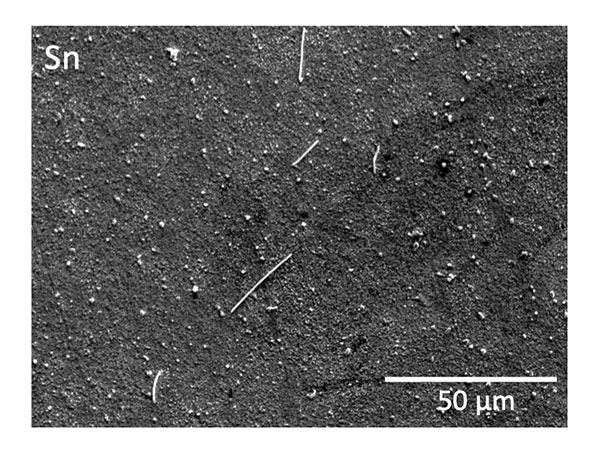A connected factory automates the AOI validation process.
Automated optical inspection (AOI) is typically used after solder reflow to detect missing components and defects. Performing a successful inspection of a panel is not enough, however. Manufacturing execution systems (MES) are used for process control and AOI data collection to ensure the following are accomplished:
- All prior routing operations passed.
- Valid test program is loaded on the machine.
- Test start- and end-times and test results are captured.
- Failed printed circuit boards (PCB) cannot advance in the production routing and must enter rework loop.
To continue reading, please log in or register using the link in the upper right corner of the page.
SAC 305 shows faster shear strength degradation than Innolot, while the surface finish has no effect.
When a solder joint is exposed to cyclic stresses, thermally activated diffusion in the bulk solder, metallization and initial intermetallic (IMC) may take place. The growth of the interfacial IMC helps relieve the residual stress induced in the solder joint, and the growth rate corresponds to the magnitude of stress induced.1 Solder joint strength also decreases during exposure to temperature variations. Therefore, shear testing is a useful method to assess solder joint strength degradation caused by thermal cycling.2
In part one3 of this series we showed the voiding, solder spread and thickness of the high-reliability Innolot alloy compared with SAC 305 alloy solder pastes using five different surface finishes. Part two discusses thermal cycling effects on the growth in IMC thickness and solder joint strength. This study included two commonly used solder alloys in paste form:
- SAC 305 (96.5%Sn, 3%Ag, 0.5%Cu) powder size distribution (PSD) type 4 with novel “CVP-390” paste flux
- Innolot (91.95%Sn, 3.8%Ag, 0.7%Cu, 3.0%Bi, 1.4%Sb, 0.15%Ni) PSD type 4 with the novel paste flux and five variations of surface finishes, including
-
- Organic solderability preservative (OSP) (MacDermid Enthone Entek Plus HT) using two thickness levels
- Immersion tin (Ormecon CSN)
- Immersion silver (MacDermid Enthone Sterling)
- Electroless nickel/immersion gold (ENIG) (MacDermid Enthone Affinity).
To continue reading, please log in or register using the link in the upper right corner of the page.
PCD&F’s annual salary survey reflects the consistency and stability of the PCB design industry.
To say much has transpired in the past year and a half is the understatement of all understatements. When we published the findings of our last designers’ salary survey in May 2020, we were still in the early months of the Covid-19 pandemic, many of us in the initial stages of a lengthy quarantine we thought was temporary. We were unsure how the virus would affect the world in the short-term, let alone the long-term – with regard to the health of loved ones and the economy as a whole, to name two of countless concerns. It will be many years before we fully comprehend the enduring global impact of this unmitigated health crisis, but if this year’s survey is any indication, one thing that has remained consistent is the PCB design engineering profession.
The US unemployment rate in July 2020 was 10.2%, and as of July 2021, it was 5.4%, according to the US Department of Labor.1 More specifically, for engineering occupations, the unemployment rate as of Jun. 30, 2020, was 6.1%, and at Jun. 30 this year, it was only 3.4%, BLS says, and the computer systems design and related services sector added 100,000 jobs in June alone.1
To continue reading, please log in or register using the link in the upper right corner of the page.
The indium additive relieves stresses that drive whisker growth.
Copper components in electronic packages (e.g., lead-frames, interconnects, integrated circuit leads and press-fit connector pins, to name a few) are often electroplated with tin (Sn) to prevent tarnishing and to facilitate subsequent soldering. With passage of time during storage or service, long whiskers grow from these tin coatings, causing electrical shorts between neighboring circuitry, posing serious reliability risks.1-3 This problem is particularly problematic in long-life applications, and failures have been reported in many arenas, including aerospace, nuclear power plants, automotive electronics, and military electronics systems, causing damages worth millions of dollars.

Figure 1. Surface of a copper substrate with a 3µm-thick electroplated coating, after ambient temperature aging for 1.5 months. The Sn version shows multiple whiskers.
A number of approaches to mitigate whisker growth have been pursued during the past 30 years, including additions of Pb, Bi, Au, Sb or Ge, or post-plating thermal treatments.4-8 These approaches mitigate whisker growth to varying degrees; however, none eliminates it. Over time, and under thermal-mechanical excursions, whiskers continue to grow.
To continue reading, please log in or register using the link in the upper right corner of the page.
From secure data exchange to managing EoL parts, the applications are numerous.
In last month’s discussion of how electronics companies first began to use Blockchain technology to automate and simplify “high-friction” multiparty processes, we noted many of the earliest projects tended to focus on the relationship between a single “sponsor” company and its partners. In other cases, companies worked together as a consortium to solve a common problem. Quickly, however, electronics companies began to leverage applications originally developed for other industries, especially to leverage the “track and trace” capability originally developed for the food industry.
Basing a new blockchain network on functionality that has been developed and implemented for another network1, even in a completely different industry, lowers the cost of entry and simplifies the process of setting up that new network. That has turned out to be very important, since it also makes it easier to create a valid business case for the application.
To continue reading, please log in or register using the link in the upper right corner of the page.
Updates in silicon and electronics technology.
Ed.: This is a special feature courtesy of Binghamton University.
Integrated photonic circuits demonstrate ultralow loss. EPFL researchers have developed a technology that produces silicon nitride integrated photonic circuits with low optical losses and small footprints. Silicon nitride has been a material of choice for applications where low loss is critical, such as narrow-linewidth lasers, photonic delay lines, and those in nonlinear photonics. The team combined nanofabrication and material science based on the photonic Damascene process developed at EPFL. With this process, the team made integrated circuits of optical losses of 1dB/m, a record value for any nonlinear integrated photonic material. That low loss considerably reduces the power budget for building chip-scale optical frequency combs used in applications that include coherent optical transceivers, low-noise microwave synthesizers, lidar, neuromorphic computing and optical atomic clocks. (IEEC file #12282, Photonics Media, 5/6/21)
Samsung develops advanced chip packaging tech. Samsung Electronics has developed an advanced chip packaging technology for high-performance applications. Its next-generation 2.5D packaging technology, Interposer-Cube4 (I-Cube4), is expected to be widely used in areas like high-performance computing, artificial intelligence, 5G, cloud and data centers with enhanced communication and power efficiency between logic and memory chips. I-Cube is heterogeneous integration technology that horizontally places one or more logic dies, such as CPU and GPU, and several high bandwidth memory dies on a paper-thin silicon interposer. (IEEC file #12285, Science Daily, 5/6/21)
To continue reading, please log in or register using the link in the upper right corner of the page.
Press Releases
- Altus Group Expands Aftersales Team to Its Largest Size to Date
- Incap Estonia Invests in New Flying robe System to Advance Production Performance
- Critical Manufacturing Partners with Canonical to Expand Cloud-Native Deployment Options for Manufacturers
- Heller Industries Becomes the Latest Partner to Join THE SMT FUTURE EXPERIENCE


